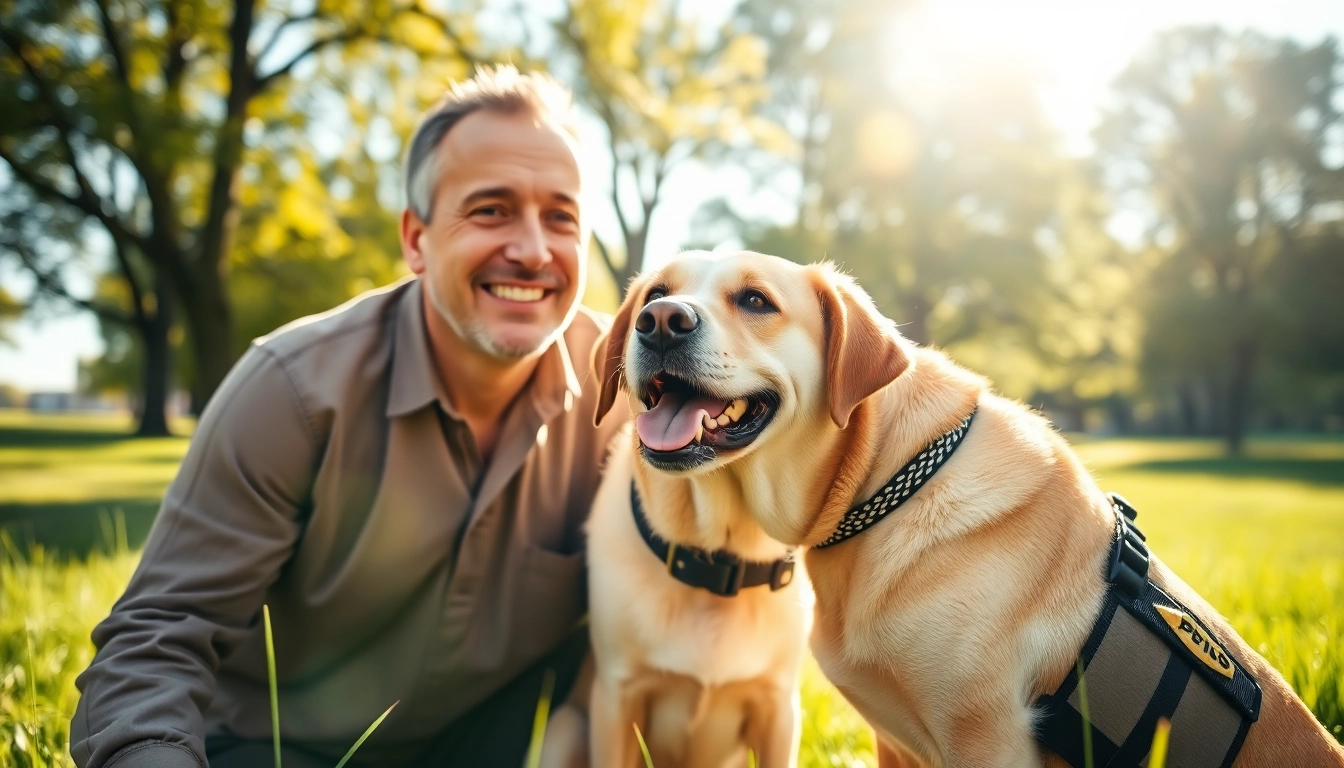Understanding PTSD and the Role of PTSD Dogs
What is PTSD?
Post-Traumatic Stress Disorder (PTSD) is a mental health condition that can develop after experiencing or witnessing a traumatic event. It is characterized by a range of symptoms including flashbacks, severe anxiety, nightmares, and uncontrollable thoughts. PTSD can affect anyone, but it is prevalent among military veterans, survivors of assault, and individuals who have witnessed accidents or natural disasters. The condition disrupts daily life and can lead to emotional distress, social isolation, and a decline in overall well-being.
The Benefits of Having a PTSD Dog
One effective way to manage PTSD symptoms is through the companionship of a specially trained dog, often referred to as a PTSD dog. These dogs provide emotional support and can help individuals reclaim their lives from the grip of PTSD. Some of the benefits of having a PTSD dog include:
- Emotional Support: PTSD dogs can sense their owner’s emotions and provide comfort during difficult times.
- Increased Safety: They can perform grounding techniques by nudging or pawing at their owner during panic attacks or anxiety episodes.
- Social Connection: Having a dog encourages social interaction, making it easier for individuals to engage with others.
- Physical Activity: Walking a dog helps to increase physical activity, which is beneficial for mental health.
- Routine and Structure: Caring for a dog requires establishing a daily routine, which can provide stability and purpose.
For many, a PTSD dog becomes a lifeline, facilitating a return to normalcy and improved mental well-being.
How PTSD Dogs Are Trained
Training a PTSD dog involves specialized techniques to address the unique needs of their owners. This training not only includes basic obedience but also specific tasks that help in alleviating PTSD symptoms. Common methods include:
- Task Training: PTSD dogs learn to perform specific tasks that assist their owners, such as retrieving medication or applying pressure to alleviate anxiety.
- Public Access Training: Dogs are trained to behave appropriately in public settings, which helps reduce anxiety for their owners.
- Behavioral Modification: Training also focuses on modifying undesirable behaviors and encouraging calmness in stressful situations.
Proper training is essential, as a well-trained PTSD dog can significantly impact the owner’s mental health and quality of life.
Selecting the Right PTSD Dog for Your Needs
Breeds Best Suited for PTSD Assistance
Not all dog breeds are suitable for working as PTSD assistance dogs. Certain breeds are known for their gentle, loyal, and supportive natures, making them more effective in this role. Some ideal breeds include:
- Golden Retrievers: Friendly and intelligent, they are easy to train and very responsive to their owner’s needs.
- German Shepherds: Known for their loyalty and protective instincts, they offer both companionship and protection.
- Labrador Retrievers: Versatile and adaptive, Labradors are often utilized for their calm demeanor and ability to connect with handlers.
- Poodles: Intelligent and hypoallergenic, they thrive on companionship and can provide emotional support effectively.
- Boxers: Their playful nature alongside loyalty makes them exceptional companions for individuals with PTSD.
Evaluating Temperament and Skills
When choosing a PTSD dog, evaluating the temperament of the dog is crucial. Look for traits such as:
- Calmness: The dog should remain composed in various situations.
- Trainability: A dog that is eager to learn will adapt better to the specific needs of a PTSD individual.
- Affectionate Nature: A dog that seeks out affection may provide the emotional support necessary for effective therapy.
Additionally, prospective owners should observe the dog’s interactions with people and other animals to gauge appropriate social behaviors.
Finding a Reputable Trainer or Organization
Finding a reputable trainer or organization that specializes in training PTSD dogs is vital. Look for:
- Certifications or affiliations with recognized training organizations.
- Positive reviews or testimonials from previous clients.
- Programs that offer follow-up support after placement.
A reputable organization often provides a comprehensive approach, ensuring the dog is well-prepared to assist someone dealing with PTSD.
Establishing a Bond with Your PTSD Dog
Building Trust and Communication
Establishing a strong bond with a PTSD dog requires patience and consistent effort. Building trust can be fostered through:
- Establishing Routine: Dogs thrive on routine and predictability, which helps build their trust.
- Positive Reinforcement: Rewarding desirable behaviors encourages good communication and strengthens the bond.
- Physical Affection: Regular petting and playtime foster a deeper emotional connection.
Daily Routines and Training Exercises
Integrating the dog into a daily routine is critical in helping them feel secure and worthwhile. Engage in:
- Regular Walks: Shared exercise promotes physical health and bonding.
- Structured Training Sessions: Daily or weekly sessions help reinforce learning and enhance communication.
- Playtime: Fun activities are vital for relationship building and emotional health.
Recognizing Signs of Stress in Your Dog
Dogs can also experience stress, which may affect their ability to assist effectively. Pay attention to signs of stress including:
- Excessive barking or whining.
- Destructive behaviors such as chewing or digging.
- Changes in eating habits or withdrawal.
Addressing any signs of stress promptly is essential to maintaining a solid and supportive relationship.
Success Stories of PTSD Dogs in Action
Real-Life Transformations and Testimonials
Numerous individuals have experienced remarkable transformations thanks to their PTSD dogs. These stories emphasize the profound impact these canine companions can have. For example, a veteran named John shared how his dog helped him navigate crowded places that previously triggered extreme anxiety.
With the dog by his side, John reported feeling calmer and more secure, allowing him to participate in social activities he had long avoided. Testimonials such as John’s illustrate the transformative potential of a supportive canine companion.
The Impact on Veterans and Their Families
Many veterans have benefited from the companionship of PTSD dogs. These dogs not only assist veterans in managing their symptoms but also positively impact family dynamics. A spouse of a vet revealed that her husband had become more emotionally available, participating in family life in ways he hadn’t been able to do for years.
PTSD dogs create an opportunity for connection, helping families reignite the relationships affected by trauma.
Lessons Learned from PTSD Dog Owners
People have learned valuable lessons from their experiences with PTSD dogs, particularly about patience, empathy, and the importance of routine. Some emphasize the need for continuous training and adaptation to evolving needs, as the bond deepens over time. Shared routines also highlight the necessity of structure, enhancing well-being for both owner and dog.
Maintaining Your PTSD Dog’s Well-being
Nutrition and Health Considerations
Just as mental health is vital for PTSD recovery, maintaining the physical health of your PTSD dog is equally important. A balanced diet and regular health checks ensure that the dog remains healthy and effective in their support role. Consider:
- Consulting a veterinarian for a diet suited to your dog’s breed, age, and activity level.
- Incorporating fresh fruits and vegetables where appropriate, alongside quality protein sources.
- Regular check-ups to monitor for health issues and ensure vaccinations are up to date.
Regular Training and Mental Stimulation
Continued training is essential in maintaining a PTSD dog’s effectiveness and mental health. Engage in:
- Advanced training exercises that challenge the dog.
- Puzzle toys and interactive games that stimulate mental faculties.
- Regular socialization with other dogs and people to maintain well-rounded behavior.
Emergency Preparedness and Support Resources
Being prepared for emergencies is crucial for both the owner and the PTSD dog. Develop a plan that includes:
- Emergency contacts for veterinary care.
- An evacuation plan that considers the needs of the dog.
- Resources for PTSD support, which may include local groups or hotlines.
Owning a PTSD dog is a commitment that requires dedication, understanding, and love. By prioritizing the well-being of both the dog and the owner, the partnership can flourish, providing mutual support and healing on the journey toward recovery.



